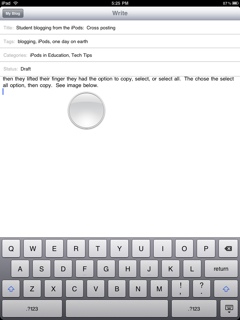Well, today I introduced the student blogs to all of my classes. What a whirlwind of a day, fairly painless as I look back over it…
Students came into class and signed out their iPods and went to the Edmodo online classroom. It is becoming a standard part of their classroom routine to go straight to Edmodo. I placed a link to their Edublogs sign in page on all of the class pages in Edmodo, this way the students do not have to type any URLs into the Safari browser, just click and go.
I popped open a page in my Class Orientation Easiteach file with an example of how their Edublogs log in looks. All of my students know their school network log-ins, their Edublogs log-ins mirrors this format with one minor exception, which is not important in this context. The point is the students were already familiar with their log-in information, this removes one obstacle in the process.
The students went to the Edublogs sign in page and typed in their Username, ready to proceed. I had all of their Usernames and Passwords on a Google Doc, so I just read the generic passwords off to the students and they logged in to their account. I should have just given all of the students the same generic password, it would have been easier. I commented on this in an earlier post.
We had the Edublogs dashboard up on the Polyvision interactive whiteboard to show the students the process of changing their password and updating their profile. They were shown how to type in the body of the blog using the “HTML” tab, as was discussed in this previous post. Students jumped on the left dashboard buttons and began exploring the site.
The students were given the Blog Expectation sheets and the explanation of the assignment. I chose a brief post where they are to introduce themselves along with a statement of what they would like to learn in class. They were to pick two objectives on subject matter and two technology objectives and explain why the topics were of interest. They have already done pieces of the assignment in class through our Edmodo discussion board and a self-reflection Google Form. My objective is to just get them writing in an appropriate voice and published out on the Internet; consider this a “shakedown cruise” before we get into the curriculum.
Most of the students started their drafts and saved them online. They are to direct message me in Edmodo when they are prepared to have their work graded. They have a rubric of what will be looked at in the assessment process, including the appropriateness of language and grammar. They were encouraged to have someone else proofread their post before they formally submit it. Hopefully they will learn how to write beyond texting and Facebook posts even though they are writing on the Web.
Overall, most students caught on quickly with the writing process on the iPods. A few of the glitches occurred because of human error, either on my part or the students. The students are great with adapting on the fly and working through issues we encounter as we try these new lessons in class.
A few students asked if there was an easier way to get into the blog so I explained about the free WordPress App and Blog Booster app for iPods. One of my students is trying out apps at home on his Droid so he can use that device instead of his home computer. I am interested in see how the apps work on that platform versus the iPods.
I plan on another post once the students complete this initial assignment, hopefully things will continue to go smoothly.
